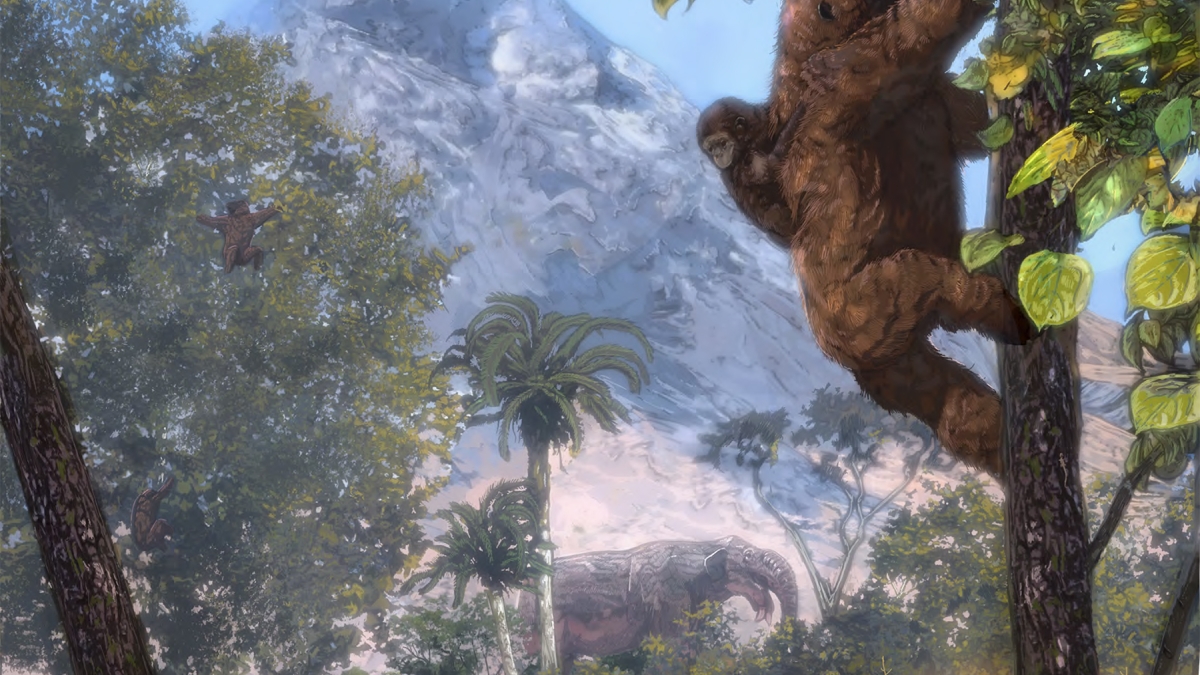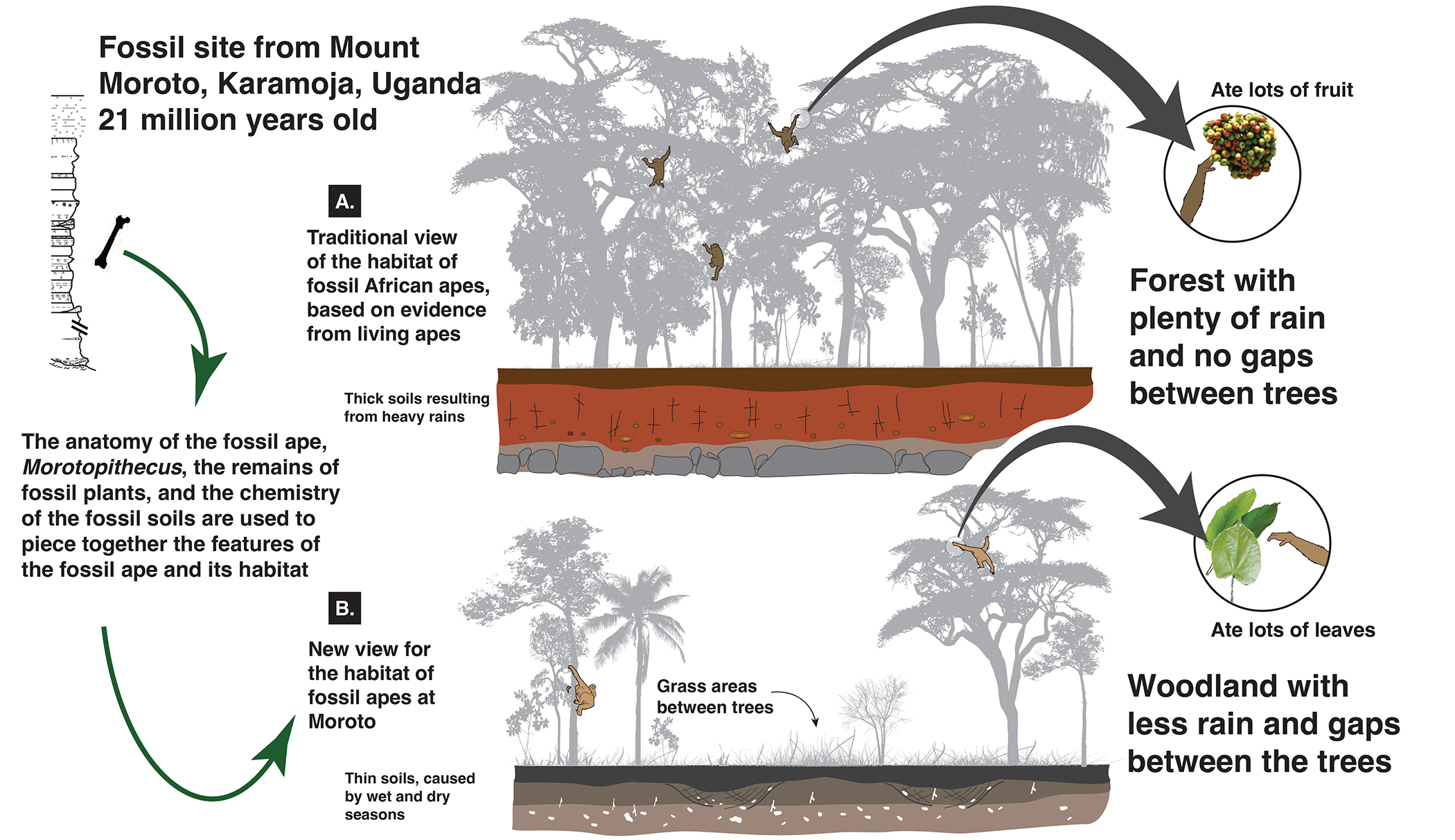New study changes perception of early apes and their environments

Artistic rendering of the open woodland habitat reconstruction at Moroto II, with Morotopithecus bishopi with an infant on their back vertically climbing and a juvenile below. Rendering courtesy Corbin Rainbolt
Anthropologists have long thought that our ape ancestors evolved an upright torso to pick fruit in forests, but new research published this week in the journal Science suggests a life in open woodlands and a diet that included leaves drove apes' upright stature.
The finding sheds light on ape origins and pushes back the origin of grassy woodlands from between 7 million and 10 million years ago to 21 million years ago, during the Early Miocene.
The new research is centered around a 21-million-year-old fossil site called Moroto in eastern Uganda. There, the international research team, which includes Arizona State University researcher Rutger Jansma, examined fossils found in a single stratigraphic layer, including fossils of the oldest, clearly documented ape, Morotopithecus.
Also within this layer were fossils of other mammals, ancient soils called paleosols and tiny silica particles from plants called phytoliths. The researchers used these lines of evidence to recreate the ancient environment of Morotopithecus.
Previous research has supported the idea that apes with an upright back must be living in forests and eating fruit. Observations of modern-day apes show the primates reach out to fruit that grows on the spindly peripheries of trees. Large apes need to distribute their weight on branches stemming from the trunk, then reach out with their hands toward their prize. This is much easier if an ape is upright because it can more easily grab onto different branches with its hands and feet.
But as more research results from Morotopithecus became available, the first surprising thing researchers found was that the ape was eating leaves. The second surprise was that it was living in woodlands.
The first clue that these ancient apes were eating leaves was in the apes' molars. The molars were very “cresty and craggy,” with peaks and valleys. Molars like this are used for tearing fibrous leaves apart, while molars used for eating fruit are typically more rounded.
ASU researcher Jansma identified another primate from the Moroto assemblage — Rangwapithecus, a smaller, siamang-sized early ape that lived alongside the larger Morotopithecus.
“Its cheek teeth are long and narrow, with sharp crests that help to break down fibrous leaves, just like Morotopithecus,” said Jansma, a faculty associate with the School of Human Evolution and Social Change. “It is not usual to find several different apes together in the Miocene, but what is strange is that at least two of them were eating leaves. Today, there are only a handful of ape species left and most of them eat fruit. This study emphasizes the importance of fossil evidence to piece together ape evolution instead of only looking at their living descendants.”
The researchers also examined the apes' dental enamel, as well as the dental enamel of other mammals found in the same stratigraphic layer. They found that isotopic ratios — the abundance of two isotopes of the same element — in their dental enamel showed that the apes and other mammals had been eating water-stressed C3 plants that are more common in open woodland or grassy woodland environments today. C3 plants are primarily woody shrubs and trees, while C4 plants are arid-adapted grasses.
The research team also discovered that the plants living in this 21-million-year-old landscape were water stressed, meaning they lived through seasonal periods of rain and of aridity. This also indicates that, at least for part of the year, apes had to rely on something other than fruit to survive.
Together, these findings reveal that Morotopithecus lived in open woodlands punctuated by broken canopy forests composed of trees and shrubs.
Therefore, the research team suggests, early apes ate leaves and lived in a seasonal woodland with a broken canopy and open, grassy areas, which drove apes' upright stature, instead of fruit in closed canopy forests.
Their results are bolstered by a companion paper published in the same issue of the journal examining the paleo grassy woodland habitats. These findings used a set of environmental proxies to reconstruct the vegetation structure from nine fossil ape sites across Africa, including the Moroto site, during the Early Miocene. These proxies revealed that C4 grasses were widespread, and the general context of open seasonal woodland ecosystems were integral in shaping the evolution of different mammalian lineages, including and especially in this research, how different ape lineages evolved.
The two papers grew out of a U.S. National Science Foundation-funded collaboration of international paleontologists, collectively known as the Research on Eastern African Catarrhine and Hominoid Evolution project, or REACHE, each of whom focus on different aspects of early ape paleoenvironments.
“These open environments have been invoked to explain human origins, and it was thought that there was a more open, seasonal environment between 10 and 7 million years ago,” said lead researcher Laura MacLatchy, from the University of Michigan.
“Such an environmental shift is thought to have been selected for terrestrial bipedalism — our ancestors started striding around on the ground because the trees were further apart. Now that we've shown that such environments were present at least 10 million years before bipedalism evolved, we need to really rethink human origins, too,” MacLatchy said. “Putting together the locomotion, the diet and the environment, we basically discovered a new model for ape origins. In anthropology, we care a lot about ape evolution because humans are closely related to apes and features like lower-back stability represent an arboreal adaptation that may have ultimately given rise to bipedal humans."
"The findings have transformed what we thought we knew about early apes and the origin for where, when and why they navigate through the trees and on the ground in multiple different ways," said Robin Bernstein, program director for biological anthropology at the National Science Foundation.
Research article: The evolution of hominoid locomotor versatility: Evidence from Moroto, a 21 Ma site in Uganda, Laura M. MacLatchy et al, Science. Companion article: Oldest evidence of abundant C4 grasses and habitat heterogeneity in eastern Africa, Laura M. MacLatchy et al, Science.
More Science and technology

Hack like you 'meme' it
What do pepperoni pizza, cat memes and an online dojo have in common?It turns out, these are all essential elements of a great…

ASU professor breeds new tomato variety, the 'Desert Dew'
In an era defined by climate volatility and resource scarcity, researchers are developing crops that can survive — and thrive —…

Science meets play: ASU researcher makes developmental science hands-on for families
On a Friday morning at the Edna Vihel Arts Center in Tempe, toddlers dip paint brushes into bright colors, decorating paper…


